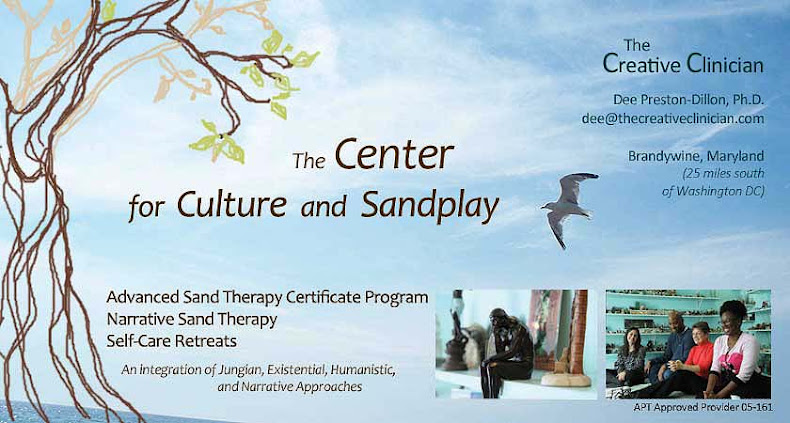• What should we consider regarding ethical use of sand, principles and best practice guidance?
• What is the role of the clinician using sand and symbols with clients?
• What clinician preparation; professional-theoretical preferences, attitudes, and perceptual ability are essential for clinician use of sand?
• What are the key distinctions in theory and practice among sand therapies?
These are a few of the questions I will address in a series of mini briefs on clinical use of sand and symbols in the Maryland/ DC Play Therapy Newsletter. These are critical questions, especially given the easy access to sand trays and objects. To understand an ethical context we have to unpack presuppositions that come with licensure across the mental health disciplines, the presumed authority and power that comes with various career positions, assumptions embedded in certifications, and careful discernment regarding training-marketing-CE features. We should consider purpose, power, and potential for both healing and devastation.
Problems with this remarkable projective process, sand therapy and its various approaches include where sand is situated within institutions and the authority related to its use, how we match theory with practice (this is a source of considerable client damage), clinician competency and preparation, and dilution of content in training/CEs. Too often we assume too much, rushing to use a projective technique, using sand as a promotional feature, dismissing potential problems, and remain unaware of the inappropriate, damaging use of sand. These are a few of the serious distortions in knowledge, skills, and practice that become problematic for clients, clinicians, sand specialists, and the profession.
There is a tremendous need for non-verbal clinical approaches such as sand that are healing for trauma, vital for non-verbal clients, and nourishing for clients with complex developmental issues. There is a need for the powerful healing, repairing capacity of sand therapy. However, if we do not slow down and examine this precious resource, what clinicians should be doing and should not be doing, we will continue to foster damaging unethical uses.
Reflecting on over thirty five years studying sand therapies and decades consulting with clinicians who use sand I see the exceptional compassion and healing qualities therapists bring to clients – the remarkable healing power of sand and symbol when the therapist is prepared – skilled in the use of interventions that follow the lead of the client, clinicians who invest time to hone their perceptual ability with a keen self-awareness. Unfortunately, I also hear the stories of children and adults who had the painful, re-wounding experience of sand – the therapist had his or her own agenda, the therapist tried to make the scene into something it was not, the therapist was more interested in the tray than the client, the therapist’s curiosity took precedence, the therapist did not know what to do with the scene and forced an issue. These stories reflect damage resulting from inappropriate use of sand and symbols. Hope rests on the integrity of all of us, graduate student to seasoned clinicians, to respect the power and preparation for using sand.
It is our responsibility to examine and set straight the misinformation and distortions resulting from diluted training and preparation, uninformed directives from management or supervision, implied readiness from internship/course instructors, and our own lack of self-awareness – presumed competencies. And there is also the waste of time with exasperating professional competition. Unfortunately we could inadvertently perpetuate these problems, generate misunderstanding, disregard the importance of clinician insights, blindly follow power or status, opt for convenience, and dismiss the vulnerabilities entailed in engagement with such depth when we choose to not question, when we avoid a reasoned unpacking. Better that we examine our rational, our reasons and practices – in training, clinical work, graduate education, and licensure.
I hope to strike a balance in this mini-series between offering tips for competent use of sand and still unpack the presuppositions, distortions, and alienating aspects of the use of sand. My goal is discernment. I hope to distinguish marketing objectives (toys, training) and implied permissions embedded in license, from essential attitudes-skills-insight – to offer light for attunement to the healing process.
©Dee Preston-Dillon, Ph.D. All Rights Reserved.
To share article, please use a link directly to this site. Other sharing prohibited.


No comments:
Post a Comment